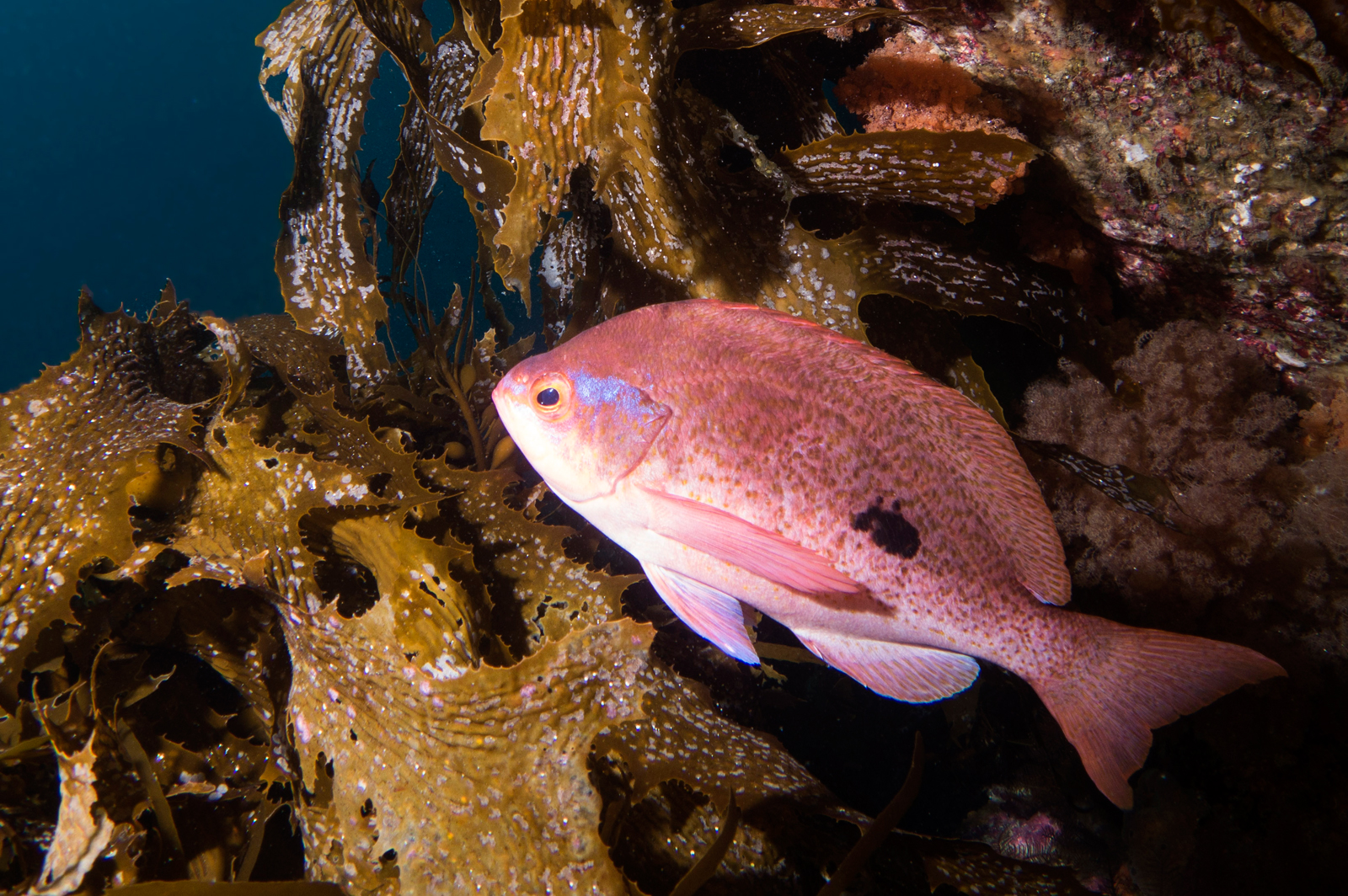- Classification
- ACTINOPTERYGII
- PERCIFORMES
- SERRANIDAE
- Caesioperca
- lepidoptera
Butterfly Perch, Caesioperca lepidoptera (Forster 1801)
Other Names: Butterfly Sea Perch, Oia, Red Perch

A Butterfly Perch, Caesioperca lepidoptera, at Bicheno, Tasmania, May 2019. Source: John Turnbull / Flickr. License: CC By Attribution-NonCommercial-ShareAlike
Summary:
A pelagic schooling fish with a pinkish body, a dark blotch on the side, blue markings around the eyes and blue fin margins in adults. Butterfly Perch school around high profile rocky reefs, outcrops and drop-offs, in depths to 100 m.
Clouds of Butterfly Perch on Needle Rock between the Big and Little Hippolyte Rocks, SE Tasmania.
Video of a huge school of Butterfly Perch amongst sponges and sea whips at Sisters Rocks, Cape Surville, SE Tasmania.
Video of Butterfly Perch at Milford Sound Underwater Observatory in the South Island of New Zealand.
Clouds of Butterfly Perch on Needle Rock between the Big and Little Hippolyte Rocks, SE Tasmania.
Video of a huge school of Butterfly Perch amongst sponges and sea whips at Sisters Rocks, Cape Surville, SE Tasmania.
Video of Butterfly Perch at Milford Sound Underwater Observatory in the South Island of New Zealand.
Cite this page as:
Dianne J. Bray, Caesioperca lepidoptera in Fishes of Australia, accessed 01 Jul 2025, https://fishesofaustralia.net.au/home/species/4371
Butterfly Perch, Caesioperca lepidoptera (Forster 1801)
More Info
|
Distribution |
Widespread in southern Australia, from about Byron Bay, New South Wales, to about Albany in Western Australia, and around Tasmania. Butterfly Perch are uncommon in Western Australia. Elsewhere, the species occurs in New Zealand. Butterfly Perch form large schools that feed on plankton above high profile rocky reefs, outcrops and drop-offs in depths of 4-100 m. Butterfly Perch shelter in caves and crevices at night. Although rarely entering bays, Butterfly Perch usually occur at shallower depths in the southern parts of their range. |
|
Features |
Dorsal fin X, 19-21; Anal fin III, 9-10; Caudal fin 17; Pectoral fin 16-17; Pelvic fin I, 5; Lateral line 52-65; Vertebrae 10 + 16. Body moderately elongate, compressed; pectoral fins elongate; dorsal fin long-based; tail forked. |
|
Size |
To a total length of about 30 cm. |
|
Colour |
Overall pinkish above, paler below. Adults are sparsely spotted, with a black blotch on sides above anal fin spines, pale blue fin margins and a blue band behind the eye. |
|
Feeding |
Feeds on zooplankton above high profile rocky reefs. |
|
Biology |
The eggs and larvae are pelagic. |
|
Fisheries |
Taken occasionally by recreational anglers. |
|
Remarks |
In some areas, Barber Perch and Butterfly Perch form mixed schools. |
|
Similar Species |
Differ from the closely-related Barber Perch, Caesioperca rasor, in having a slightly deeper body, and males are more pinkish with a dark blotch rather than a vertical bar on the midsides. |
|
Etymology |
|
|
Species Citation |
Epinephelus lepidopterus Forster, 1801, Systema Ichthyologiae: 302. Type locality: New Zealand |
|
Author |
Dianne J. Bray |
|
Resources |
|
Butterfly Perch, Caesioperca lepidoptera (Forster 1801)
References
Edgar, G.J. 2008. Australian Marine Life: the plants and animals of temperate waters. Sydney : Reed New Holland 2, 624 pp.
Forster, J.R. in Bloch, M.E. & Schneider, J.G. 1801. Systema Ichthyologiae Iconibus ex Illustratum. Berlin 584 pp. 110 pls.
Kuiter, R.H. 1993. Coastal Fishes of South-eastern Australia. Bathurst : Crawford House Press 437 pp.
Kuiter, R.H. 1994. Families Serranidae, Callanthiidae. pp. 528-548 figs 469-485 in Gomon, M.F., Glover, C.J.M. & Kuiter, R.H (eds). The Fishes of Australia's South Coast. Adelaide : State Printer 992 pp. 810 figs
Kuiter, R.H. 1996. Guide to sea fishes of Australia. A comprehensive reference for divers and fishermen. Sydney, NSW, Australia : New Holland Publishers xvii, 434 pp.
Last, P.R., Scott, E.O.G. & Talbot, F.H. 1983. Fishes of Tasmania. Hobart : Tasmanian Fisheries Development Authority 563 pp. figs
May, J.L. & J.G.H. Maxwell. 1986. Trawl fish from temperate waters of Australia. CSIRO Division of Fisheries Research, Tasmania. 492 pp.Roberts, C.D. & Gomon, M. F. 2008. Families Polyprionidae, Serranidae and Callanthiidae. pp. 534-549 in Gomon. M.F., Bray, D.J. & Kuiter, R.H (eds). Fishes of Australia's Southern Coast. Sydney : Reed New Holland 928 pp.
Russell, B.C. 1983. The food and feeding habits of rocky reef fish of north-eastern New Zealand. N.Z. J. Mar. Freshwat. Res. 17(2): 121-145.










